Rivera Sun's Blog: From the Desk of Rivera Sun, page 31
December 19, 2015
Every Heart Contributes to the Healing of the Whole
 (This is a guest post from Sherri Mitchell, a member of the Penobscot Nation, Indigenous Rights Attorney, and my cohost on Love (and Revolution) Radio which premiers Jan 6, 2016.)
(This is a guest post from Sherri Mitchell, a member of the Penobscot Nation, Indigenous Rights Attorney, and my cohost on Love (and Revolution) Radio which premiers Jan 6, 2016.)
As a revolutionary, street corner activist, or even as a human being that is trying to make their tiny corner of the world a better place, it’s important to remember that we are all doing the best that we can, to help heal this world, to secure our survival and to achieve lasting peace. We all have our own individual areas of focus, our own skill sets, our own belief systems, and our own limitations. One of the most distressing things that I encounter, in myself and in others, is this tendency to think that our efforts are not enough; that the efforts of others are not enough.
When someone takes a stand or position on an issue that we are passionate about, we tend to immediately point out how they are failing to address it properly. We point out all the ways that they are failing, or not doing enough, rather than recognizing and praising the small amount of good that is being accomplished. Every bit of good that is done in this world helps move us forward. Every heart that is softened, by any issue or cause, becomes more pliable and open. We have to be able to recognize the broader benefit of the work being done, on many fronts, and recognize that it is all adding to the good. Whether you’re working to protect children, the environment, animals, or on any number of other basic human or earth based rights issues, you are contributing something beneficial to the evolution of this world.
You are important, your work is important, and it is greatly needed.
We have some urgent issues that need solving immediately, so that we can continue to live here on this beautiful planet. We need to protect the water, preserve our ability to live sustainably in harmony with Mother Earth, and reduce the instances of violence. This will give us the space and time needed to solve the many other problems that we face. However, this doesn’t mean that all of those other issues aren’t important, nor does it minimize the value of the work that is being done to address them. Every commitment that is made to make this world a more loving, thoughtful and humane place is important. Every heart and mind that can be turned toward love and compassion is essential. The shift that we need will not come by force, it will not come by solving any one issue. It will come from hearts and minds being moved by love and compassion toward other living beings: two legged, four legged, winged and crawling, trees, plants, air and water.
When we recognize and praise the good that is being done, it amplifies the good. When we condemn and judge others for not focusing on the right issue, or not going far enough, we amplify the negativity and the sense of hopelessness that so many feel. We can’t allow issue alignment to be another means of separating us. No one can solve every problem. In fact, their power is diminished when it gets dispersed over too many issues. We need to honor the work being done by every one of us. We need to recognize and appreciate the compassion and commitment that drives each person to their own individual work. And, we need to amplify our sense of kinship, appreciation and respect for one another.
In the end, I believe that the tide will shift not as a result of the work of any one group, working on any one issue, but from a global elevation in consciousness. This will come from minds and hearts opening toward one another, with a deep recognition of our intrinsic connections to one another and all life. The energy for that shift is amplified when we look at one another with appreciation, love and respect. When we step back and see the whole picture from a spiritual perspective and recognize that every loving thought, breath, and action is contributing to a kinder, more thoughtful and loving world, we will come to understand our true power.
I honor all those contributing to the creation of a kinder, more thoughtful and loving world, from all corners and from all fronts. You are valued and deeply appreciated. Kci Woliwon, nitaps naka nitap’esgs. Komac koselmol
 Sherri Mitchell (Penobscot) is an Indigenous rights attorney, writer and activist who melds traditional life-way teachings into spirit-based movements. Follow her at Sherri Mitchell – Wena’gamu’gwasit
Sherri Mitchell (Penobscot) is an Indigenous rights attorney, writer and activist who melds traditional life-way teachings into spirit-based movements. Follow her at Sherri Mitchell – Wena’gamu’gwasit
December 17, 2015
The Danes Saved More Than 7,000 Jews . . . Would We?
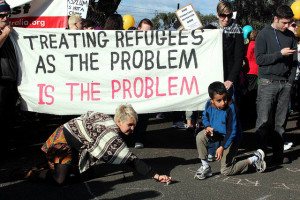
Treating Refugees as the problem is the problem – Refugee Rights Protest at Broadmeadows, Melbourne
(This essay was originally part of a longer essay addressing five stories of nonviolent resistance to the Nazis and the parallels that can be applied to current events in the United States.)
Those who cannot remember the past are condemned to repeat it,” said philosopher George Santayana, and in a time when presidential candidates are repeating the behaviors of Hitler and Nazi Germany, we would be wise to study the profound examples of resistance to intolerance and extremism. There are many notable examples, and among them, Danish resistance shines.
The Danish resistance to Nazi occupation contains many chapters, each with dazzling tactics and creative solutions. There is none more jaw-dropping, however, than the Danish people’s rescue of 7,220 of their 7,800 Jews. On September 28th, 1943, Nazi occupation forces intended to arrest the entire Jewish population of Denmark and transport them to concentration camps. Word of the plan leaked, however, and thousands of Danes hid the Jews in their homes. Fishermen ferried the Jews across the ocean to nearby Sweden, saving all but a few hundred people.
The rescue was facilitated by a few factors: a German diplomat, Georg Ferdinand Duckwitz, not only leaked the warning of the round-up, he had also attempted earlier to secure asylum for the Danish Jews in Sweden. Also, the Jewish population of Denmark was held in high regard, and fully integrated into society. The Nazis’ earlier attempts to discriminate against the Jews had been roundly rebuffed by the Danes. When the orders of the round-up occurred, Danish citizens saw it as an affront to all Danes, and mobilized to protect their fellow countrymen and women.
The question this raises for us, as American citizens, is would we do the same? During World War II, we allowed our fellow citizens of Japanese descent to be interred in camps. We allow our political figures to spout anti-Muslim rhetoric and threaten to put all Muslims and refugees in camps. When our turn comes, will we stand up with organized nonviolent action and protect our fellow human beings? Do we have in our hearts, the greatness of spirit demonstrated by the Danes?
And if not, let us begin the work of changing our culture. Let us assert the values of human dignity, our shared humanity, human rights and civil rights. In conversation, writing, on the radio, and in our actions, we must put forth the values for which we stand. Only then, when the moment of crisis comes, can we be assured that our populace will respond in a way that will withstand the critique of history.
Learn more about Danish Resistance to Nazi occupation:
http://nvdatabase.swarthmore.edu/content/danish-citizens-resist-nazis-1940-1945
________________________________
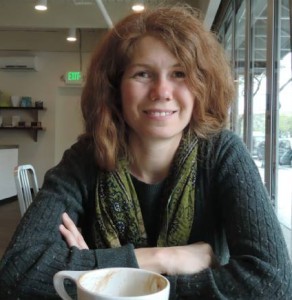 Author/Activist Rivera Sun, syndicated by PeaceVoice, is the author of The Dandelion Insurrection, Billionaire Buddha and Steam Drills, Treadmills, and Shooting Stars, the cohost of Occupy Radio and Love (and Revolution) Radio, and the cofounder of the Love-In-Action Network. She is a trainer and social media coordinator for Campaign Nonviolence and Pace e Bene. Sun attended the James Lawson Institute on Strategic Nonviolent Resistance in 2014 and her essays on social justice movements appear in Truthout and Popular Resistance. www.riverasun.com
Author/Activist Rivera Sun, syndicated by PeaceVoice, is the author of The Dandelion Insurrection, Billionaire Buddha and Steam Drills, Treadmills, and Shooting Stars, the cohost of Occupy Radio and Love (and Revolution) Radio, and the cofounder of the Love-In-Action Network. She is a trainer and social media coordinator for Campaign Nonviolence and Pace e Bene. Sun attended the James Lawson Institute on Strategic Nonviolent Resistance in 2014 and her essays on social justice movements appear in Truthout and Popular Resistance. www.riverasun.com
December 16, 2015
Sanctuary For Refugees: André Trocmé and Le Chambon-sur-Lignon
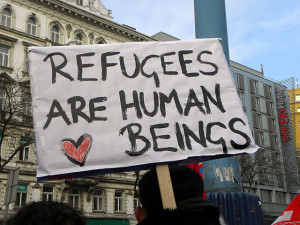
“2013-02-16 – Wien – Demo Gleiche Rechte für alle (Refugee-Solidaritätsdemo) – Refugees are human beings” by Haeferl – Own work. Licensed under CC BY-SA 3.0
(This essay was originally part of a longer essay addressing five stories of nonviolent resistance to the Nazis and the parallels that can be applied to current events in the United States.)
Recent comments by US politicians have left many troubled, worried about a replay of Nazi-era Germany here in the United States. The specter of the Jewish Holocaust recast upon Muslim and refugee bodies haunts many. In times such as these, the stories of courageous, organized resistance to the Nazis bear repeating. Of these, the efforts of a French priest can serve as example to us all.
André Trocmé was trouble for those who favored war and violence. He was sent to a remote parish in the mountains of France for his pacifist views, but as the Nazis invaded and occupied France, Andre discovered he was in a unique position to join the international network of people resisting the Nazis and the persecution of the Jews. He and his wife, Magda, and his deputy worked with the villagers and parishioners of Le Chambon-sur-Lignon to create a series of safe houses for fleeing Jews. The local schools enrolled children under false names, and met them at the train station as if welcoming family members into their homes. When the anti-Jew Vichy government caught on, they sent gendarmes to search the village. When asked to produce a list of Jews, Trocmé replied, “We do not know what a Jew is. We only know men.” It is estimated that between 1940-1945, the village saved the lives of 3,500-5,000 Jewish refugees.
Flash-forward to September-November 2015: Syrian refugees are fleeing violence, civil war, airstrikes, terrorist groups, and extreme repression. They flood the shores of Europe. In Hungary, Sweden, and Greece, the governments ban the refugees. But citizens rise up, nonviolently, flock to the train stations, defy their officials, and welcome the refugees into their countries. Then, in November, terrorists attack and kill 130 in Paris. The Syrian refugees are scapegoated. Thirty-one United States governors overstretch their authority and issue statements saying they will not accept Syrian refugees in their states.
What are we going to do? The moral obligation of compassion is clear. Our governors, like the officials in Europe, like the Vichy government and the Nazis, and all the cruel oppressors throughout history, must be resisted nonviolently. Like André Trocmé and Le Chambon-sur-Lignon, we must make our communities havens for those fleeing violence and death. We must open our hearts and homes to provide sanctuary to our fellow human beings, even going to great risks to assure that our common humanity is not destroyed by the bigotry and hatred of the times. Refugees are seeking refuge . . . and all philosophies, faiths, and spiritualties call upon us to offer such sanctuary in the midst of the storms of violence and war.
Resisting modern-day Hitlers and Nazis—from ISIS to Trump—requires opening our hearts to those being persecuted by the politics of hatred. In our times, this means Muslims, refugees, immigrants, homeless, the poor, and a great many more. Like Trocmé and the villagers, we find ourselves in times of crisis, being required to do extraordinary acts in the midst of our ordinary human lives. Like Trocmé, we each have this capacity within us, a seed of compassion just waiting to unfurl.
“Look hard for ways to make little moves against destructiveness.” – André Trocmé
Learn more about André and Magda Trocmé here.
___________________________________
Author/Activist Rivera Sun, syndicated by PeaceVoice, is the author of The Dandelion Insurrection, Billionaire Buddha and Steam Drills, Treadmills, and Shooting Stars, the cohost of Occupy Radio and Love (and Revolution) Radio, and the cofounder of the Love-In-Action Network. She is a trainer and social media coordinator for Campaign Nonviolence and Pace e Bene. Sun attended the James Lawson Institute on Strategic Nonviolent Resistance in 2014 and her essays on social justice movements appear in Truthout and Popular Resistance. www.riverasun.com
~~~~~~~~~~~~~~~~~~
December 14, 2015
Nonviolence vs. Nazis: Five Lessons to Trounce Trump
US politics are enough to give everyone nightmares of Donald Trump as Hitler minus the mustache. He’d drop a nuke on ISIS. He wants a registry of all Muslims. He decries economic inequality while profiting from and being the epitome of the problem. He’s white, male, and millions of prejudiced, mass media skewed Americans seem to adore him.
But while we’re dusting off the ghosts of Nazi Germany, remember that history not only holds stories of horrors and atrocities, but also stories of courage, heroism, and resistance. Let us therefore evoke five stories of nonviolent resistance to the Nazis: Sophie Scholl and the White Rose, André and Magda Trocmé and the citizens of Le Chambon-sur-Lignon, the Berlin women of the Rosenstrasse protests, the Norwegian Teachers’ Defense of Education, and the Danish rescue of the Jews.
Those of us who choose nonviolent action as a form of making change, are often challenged with the question, “But what about the Nazis?” These stories are the reply to that question. Widespread nonviolent struggle was never used against the Nazis, but wherever it was used, it was quite successful. From the courageous efforts of our forbearers in the lineage of nonviolence, we can draw the inspiration for mass action and widespread nonviolent resistance. If we must face the frightful specter of an American Hitler, let us pick up the torch of those who came before and go boldly into new frontiers of organized nonviolent resistance.
Know your history, my friends, for when history repeats, those who do not know the stories of nonviolent resistance are doomed to perish in the horrors of genocide, violence, and war. Those who know these five stories, however, will glean from them the wisdom, inspiration, and ideas for practical action that empower us to end fear, hatred, bigotry, and violence.
Sophie Scholl and the White Rose
In 1942, a young German woman, Sophie Scholl joined the White Rose, a group dedicated to nonviolent resistance of the Nazis, particularly through spreading forbidden literature about nonviolent resistance. As a child, she, like all of her school friends, had joined the girl’s wing of the Nazi Party youth movement. However, she grew alarmed at the political views and the dangerous rise of Nazi ideology. Over the next ten years, she consistently chose to dissent from her peers. In university, she discovered her brother Hans and friends had started the White Rose and quickly joined. On February 18th, 1943, Sophie and Hans were spotted doing a leaflet drop from the top of a university tower, arrested, brutally interrogated by the Gestapo, put on trial without lawyers, and executed by guillotine on February 22nd. Sophie Scholl was twenty-two years old.
The point of Sophie’s story is not her death . . . it is her life of conviction and courage that offers inspiration for our own lives. If we live in a time when one of our presidential candidates does not seem to mind being compared to Hitler, then we must organize in such a way that we can be compared to Sophie Scholl and the White Rose. We must challenge the hatred and bigotry of our day, withdrawing from social clubs and institutions that support xenophobia and racism. We must consciously take the stance of respect and justice even if it runs contrary to the opinions of our peers or neighbors. We should share knowledge of how to nonviolently resist the injustices wrought by our nation. We should write, print, and distribute literature calling upon our shared human values of respect, peace, justice, equality, and kindness. We should use our new online technologies to do so, as well.
We, unlike, Sophie Scholl and her fellow students in Germany, have the Freedom of Speech. Her life, her death, her courage and sacrifice should serve as our reminder to use it, now, not tomorrow or next week, but today.
“Somebody, after all, had to make a start. What we wrote and said is also believed by many others. They just don’t dare express themselves as we did.” – Sophie Scholl
Learn more about Sophie Scholl here.
And don’t miss this excellent article on the White Rose!
André Trocmé and the Sanctuary of Le Chambon-sur-Lignon
André Trocmé was trouble for those who favored war and violence. He was sent to a remote parish in the mountains of France for his pacifist views, but as the Nazis invaded and occupied France, Andre discovered he was in a unique position to join the international network of people resisting the Nazis and the persecution of the Jews. He and his wife, Magda, and his deputy worked with the villagers and parishioners of Le Chambon-sur-Lignon to create a series of safe houses for fleeing Jews. The local schools enrolled children under false names, and met them at the train station as if welcoming family members into their homes. When the anti-Jew Vichy government caught on, they sent gendarmes to search the village. When asked to produce a list of Jews, Trocmé replied, “We do not know what a Jew is. We only know men.” It is estimated that between 1940-1945, the village saved the lives of 3,500 Jewish refugees.
Flash-forward to September-November 2015: Syrian refugees are fleeing violence, civil war, airstrikes, terrorist groups, and extreme repression. They flood the shores of Europe. In Hungary, Sweden, and Greece, the governments ban the refugees. The citizens rise up, nonviolently, flock to the train stations, defy their officials, and welcome the refugees into their countries. Then, in November, terrorists attack and kill hundreds of people in Paris. The Syrian refugees are scapegoated. Thirty-one United States governors overstretch their authority and issue statements saying they will not accept Syrian refugees in their states.
What are we going to do? The moral obligation of compassion is clear. Our governors, like the officials in Europe, like the Vichy government and the Nazis, and all the cruel oppressors throughout history, must be resisted nonviolently. Like André Trocmé and Le Chambon-sur-Lignon, we must make our communities havens for those fleeing violence and death. We must open our hearts and homes to provide sanctuary to our fellow human beings, even going to great risks to assure that our common humanity is not destroyed by the bigotry and hatred of the times. Refugees are seeking refuge . . . and all philosophies, faiths, and spiritualties call upon us to be offer such sanctuary in the midst of the storms of violence and war.
Resisting modern-day Hitlers and Nazis requires opening our hearts to those being persecuted by the politics of hatred. In our times, this means Muslims, refugees, immigrants, the homeless, the poor, and a great many more. Like Trocmé and the villagers, we find ourselves in times of crisis, being required to do extraordinary acts in the midst of our ordinary human lives. Like Trocmé, we each have this capacity within us, a seed of compassion just waiting to unfurl.
“Look hard for ways to make little moves against destructiveness.” – André Trocmé
Learn more about André and Magda Trocmé here.
The Women of Berlin, Rosenstrasse Protest
In 1943, Joseph Goebbels promised Adolf Hitler that Berlin would be Judenfrei – Jew free – in time for Hitler’s birthday. On February 27th, without warning, Jews were snatched off the streets and from workplaces, and held in buildings temporarily before being loaded onto trains to be sent to their deaths in the concentration camps. This was the fate of nearly 6,000 Jews in Berlin. Another group, the 1,800 Jews with non-Jewish German wives, were rounded up according to a separate list, and held in a building on Rosenstrasse, Rose Street. The German women, upon discovering their husbands were gone, raced to the location and began an impromptu unarmed, nonviolent demonstration demanding the release of their husbands. For a full week, hundreds to a thousand women protested night and day, defying orders to disperse, withstanding threats of being shot to death. The German Gestapo office sat within earshot; the women persisted despite the danger. On March 6th, as thousands of other Jews were being sent to Auschwitz, the husbands of these Berlin women were released. Even the thirty-eight who had already been sent to the camps were returned to Berlin. It is said that the Rosenstrasse protest also halted the plans to round up the intermarried Jews in France, a change that saved thousands of lives. The German government felt that the dissent and visible signs of resistance would be detrimental at this time, and that releasing the men was easier than risking more uprisings.
Today, as Islamophobia and anti-refugee rhetoric is whipping the American populace into a frenzy of fear, we need not wait until the eleventh hour to see where this type of discrimination leads. Before politicians allow bigots to require Muslims to register (like the Jews in the 1940s), or wear a symbol (like the yellow star), or be deported to concentration camps, let us take a chapter out of German history – the Rosenstrasse chapter, that is. If the threatened registry appears, let us protest it, or sign it en masse as an act of protest. If the parallel to the yellow star occurs, let us all, as citizens, resist the labels unanimously. Let us remember the words of Martin Niemöller:
First they came for the Socialists, and I did not speak out—
Because I was not a Socialist.
Then they came for the Trade Unionists, and I did not speak out—
Because I was not a Trade Unionist.
Then they came for the Jews, and I did not speak out—
Because I was not a Jew.
Then they came for me—and there was no one left to speak for me
And if they come for any of us, let us be prepared to use nonviolent action, like the women of Berlin, to rescue not just our loved ones, but all of our human brothers and sisters, so that the tragedy of the Holocaust can never be repeated. With courage and preparation and knowledge, we can stop the dangerous cycle of history from repeating in the context of our contemporary lives.
Read more about the Rosenstrasse protests here.
Norwegian Teachers’ Defense of Education
In April 1940, the Nazis invaded Norway and occupied the country. In 1942, as part of an attempt to implement a fascist curriculum in the schools, Minister-President Vidkun Quisling, a Norwegian collaborator, disbanded the existing teachers’ union and required all teachers to register with the new Norwegian Teachers’ Union by February 5th. Between 8,000-10,000 of Norway’s 12,000 teachers responded by signing a letter of refusal to cooperate. The Quisling government panicked and closed the schools, sending the children home to their parents. 200,000 of these annoyed parents wrote letters of protest to the government. Norwegian teachers began to hold classes in secret, in defiance of orders. The government ordered the arrest of a thousand teachers, five hundred of whom were sent to a prison camp in the Arctic.
As the trainloads of teachers were shipped north, students and families gathered along the tracks, singing and offering food to the teachers as they passed. Once in prison, the teachers formed choirs and offered lectures to one another. The government tried numerous intimidation tactics, but the strike continued. On November 4th, 1942, the Quisling government released all the teachers and abandoned their earlier plans. The Norwegian teachers, through nonviolent resistance, had defended their youth from being subjected to fascist curriculum, and protected Norway from sliding into a fascist state.
The Norwegian Teachers’ Defense of Education offers pearls of strategic wisdom for us as we see a rise of bigotry and hatred in the United States. Resist and organize amongst your professional colleagues. It was not individual action that produced such a successful campaign, but rather collective action through an entire profession, supported by students and parents. As we see a rise of fear and hatred, look carefully at the intersection of your profession and cultural indoctrination. Perhaps this is a place where a line of resistance can form. Churches, schools, media, universities, and large institutions are all places to address and resist the dangerous slide toward fear-based bigotry and hatred. Talk with one another, initiate conversations, prepare strategies, share stories like this one, and ideas for how your profession might take a stand together. Like the Norwegian teachers, each of us – in our profession and personal lives – forms a line of defense in the heart of our culture. Here we can wage nonviolent struggle for compassion, respect, equality, and dignity.
Read more about the Norwegian Teachers’ Defense of Education here.
Denmark Saves 7,220 Jewish Citizens
The Danish resistance to Nazi occupation contains many chapters, each with dazzling tactics and creative solutions. There is none more jaw dropping, however, than the Danish people’s rescue of 7,220 of their 7,800 Jews. On September 28th, 1943, Nazi occupation forces intended to arrest the entire Jewish population of Denmark and transport them to concentration camps. Word of the plan leaked, however, and thousands of Danes hid the Jews in their homes. Fishermen ferried the Jews across the ocean to nearby Sweden, saving all but a few hundred people.
The rescue was facilitated by a few factors: a German diplomat, Georg Ferdinand Duckwitz, not only leaked the warning of the round-up, he had also attempted earlier to secure asylum for the Danish Jews in Sweden. The Jewish population of Denmark was held in high regard, and fully integrated into society. The Nazis’ earlier attempts to discriminate against the Jews had been roundly rebuffed by the Danes. When the orders of the round-up occurred, Danish citizens saw it as an affront to all Danes, and mobilized to protect their fellow countrymen and women.
The question this raises for us, as American citizens, is would we do the same? During World War II, we allowed our fellow citizens of Japanese descent to be interred in camps. We allow our political figures to spout anti-Muslim rhetoric and threaten to put all Muslims and refugees in camps. When our turn comes, will we stand up with organized nonviolent action and protect our fellow human beings? Do we have in our hearts, the greatness of spirit demonstrated by the Danes?
And if not, let us begin the work of changing our culture. Let us assert the values of human dignity, our shared humanity, human rights and civil rights. In conversation, writing, on the radio, and in our actions, we must put forth the values for which we stand. Only then, when the moment of crisis comes, can we be assured that our populace will respond in a way that will withstand the critique of history.
Learn more about the rescue of the Jewish Danes.
Learn more about Danish Resistance to Nazi occupation.
____________________________
 Author/Activist Rivera Sun, syndicated by PeaceVoice, is the author of The Dandelion Insurrection, Billionaire Buddha and Steam Drills, Treadmills, and Shooting Stars, the cohost of Occupy Radio and Love (and Revolution) Radio, and the cofounder of the Love-In-Action Network. She is a trainer and social media coordinator for Campaign Nonviolence and Pace e Bene. Sun attended the James Lawson Institute on Strategic Nonviolent Resistance in 2014 and her essays on social justice movements appear in Truthout and Popular Resistance.www.riverasun.com
Author/Activist Rivera Sun, syndicated by PeaceVoice, is the author of The Dandelion Insurrection, Billionaire Buddha and Steam Drills, Treadmills, and Shooting Stars, the cohost of Occupy Radio and Love (and Revolution) Radio, and the cofounder of the Love-In-Action Network. She is a trainer and social media coordinator for Campaign Nonviolence and Pace e Bene. Sun attended the James Lawson Institute on Strategic Nonviolent Resistance in 2014 and her essays on social justice movements appear in Truthout and Popular Resistance.www.riverasun.com

December 7, 2015
North Country Mornings
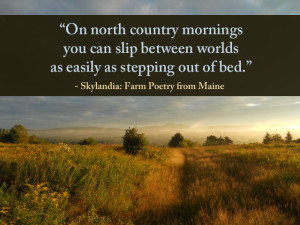 North Country Mornings
North Country Mornings
from Skylandia: Farm Poetry
by Rivera Sun
On north country mornings,
you can slip between worlds
as easily as stepping out of bed,
rising half-groggy,
and walk out into the mist.
Light frost etching lace
on every gold meadow stalk,
fog hung off the ponds
hushed and reverent,
breath of earth
on the air.
Grasses standing frozen
alongside ochre
and umber
bronze wild plants
caught in bloom,
each seed head
separated in frost,
each short blade
spiked straight up
from the ground.

Near the pine trees, you can see my tiny cabin. Down the hill, out of the frame is the hundred year old farmhouse.
The old farm road,
leads only to mysteries,
the veil of morning
still lowered
to the edge
of the forest.
You hover,
bewitched,
as the light rises
fog lifts
and the land yawns
its way into day.
A note from Rivera: Skylandia: Farm Poetry is a collection of poems reflecting on my childhood growing up on an organic farm in Maine. These are scratchy, bug-bitten poems; sweet loam scented poems; snowflakes in your hair poems . . . stories about family, obnoxious politicians, rugged farmers and old French Acadians. They’re tactile verses, full of emotion and texture. Writing them brought great joy to me, as if I were tromping the fields and forests once again. My family still farms up there on the border of Canada. It is still magical and mysterious. It still calls to me.
Skylandia: Farm Poetry from Maine is on sale for the holidays! Until Dec 15th, you can get it at this discount rate. Enjoy! Find other discounts and specials here.
 Skylandia: Farm Poetry from MaineIn a collection of writings delightfully and aptly referred to as "farm poetry", author Rivera Sun reveals an intimate portrait of her days growing up on an organic farm in Maine. With wry humor and lavish precision, the words of this volume evoke the essence of pine forests, summer fields, cold snow . . . and the authenticity of a farm girl in Maine. Gift Wrap : No Gift Wrap Gift Wrap [+ $4.00] Price: $13.99
Skylandia: Farm Poetry from MaineIn a collection of writings delightfully and aptly referred to as "farm poetry", author Rivera Sun reveals an intimate portrait of her days growing up on an organic farm in Maine. With wry humor and lavish precision, the words of this volume evoke the essence of pine forests, summer fields, cold snow . . . and the authenticity of a farm girl in Maine. Gift Wrap : No Gift Wrap Gift Wrap [+ $4.00] Price: $13.99
December 6, 2015
Love like the High Desert and the Rain
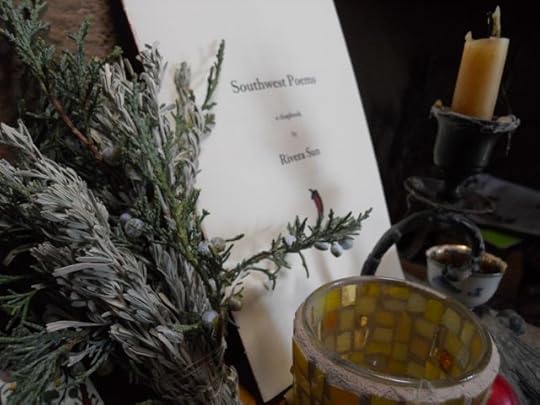 Sitting on my altar, in the place of honor all new writing creations share, is this hand-stitched poetry chapbook (pictured right) that I made recently as part of my “Ode to the Southwest” holiday gift package (with sage, piñon incense, and some treats I’ve grown to love while living here). Here’s my favorite poem from the collection. Enjoy!
Sitting on my altar, in the place of honor all new writing creations share, is this hand-stitched poetry chapbook (pictured right) that I made recently as part of my “Ode to the Southwest” holiday gift package (with sage, piñon incense, and some treats I’ve grown to love while living here). Here’s my favorite poem from the collection. Enjoy!
Love, my friends,
love . . .
like the high desert and the rain
crack open
with readiness and longing
like the fine clay dust
taste that sharp iron yearning of
split lips licked bloody by drought
hear the electric smack of thunder
and the far-off heartbeat, rumbling
tense your limbs in anticipation
feel the barometer dropping
gasp when the wet wind
shocks you with its arrival
pant at the rain
that is coming
so slow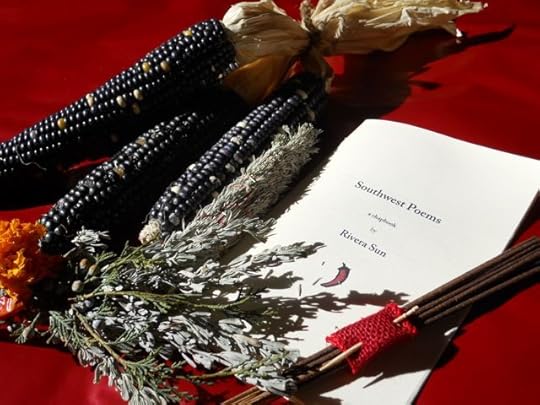
droplets walking
inch by inch
across the skin of the earth’s body
release the sweet sigh of sage
that every lover knows.
-by Rivera Sun in Southwest Poems, a limited edition chapbook made as a special holiday treat.
You can find the chapbook and other special holiday items (including discounts on novels) here: http://www.riverasun.com/holiday-gifts-and-specials/
December 1, 2015
Looking Home-Grown Terrorism In the Eye
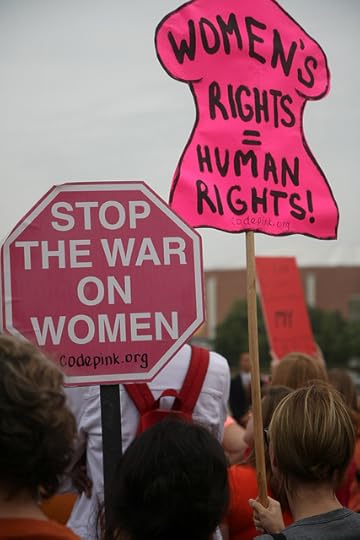
Women’s Rights = Human Rights!
Stop the War on Women
National Day of Action to Defend Women’s Rights. Rally at Dallas City Hall, July 15, 2013. by Steve Rainwater https://www.flickr.com/photos/steevit...
(This is a guest post from Sherri Mitchell, a member of the Penobscot Nation, Indigenous Rights Attorney, and my cohost on Love (and Revolution) Radio which premiers Jan 1, 2016.)
Carly Fiorina’s lies directly resulted in the attack at Planned Parenthood. There is no denying this, since the shooter quoted her when he was apprehended.
This isn’t the first time that GOP rhetoric has led to the death of innocent people. In the early 80’s, Ronald Reagan gave an impassioned speech calling on people to stop abortionists by any means necessary. This led to several shooting deaths, arson and bombings at women’s clinics around the country by Christian extremists.
When someone directly influences another and causes them to commit a crime they are complicit in that crime. And, in my opinion, they should be held liable for inciting violence.
Here’s a short list of “some” of the American terrorist activities that have occurred in this country in the last 30 years:
May 26, 1983: Joseph Grace set the Hillcrest clinic in Norfolk, Virginia ablaze. He was arrested while sleeping in his van a few blocks from the clinic when an alert patrol officer noticed the smell of kerosene.
May 12, 1984: Two men entered a Birmingham, Alabama clinic shortly after a lone woman opened the doors at 7:45 am. Forcing their way into the clinic, one of the men threatened the woman if she tried to prevent the attack while the other, wielding a sledgehammer, did between $7,500 and $8,000 of damage to suction equipment. The man who damaged the equipment was later identified as Father Edward Markley. Father Markley is a Benedictine monk who was the Birmingham diocesan “Coordinator for Pro-Life Activities”. Markley was convicted of first-degree criminal mischief and second-degree burglary. His accomplice has never been identified. Following the Birmingham incident, Markley entered the Women’s Community Health Center in Huntsville Alabama, assaulting at least three clinic workers. One of the workers, Kathryn Wood received back injuries and a broken neck vertebrae. Markley was convicted of first-degree criminal mischief and three counts of third-degree assault and harassment in the Huntsville attack.
December 25, 1984: An abortion clinic and two physicians’ offices in Pensacola, Florida, were bombed in the early morning of Christmas Day by a quartet of young people (Matt Goldsby, Jimmy Simmons, Kathy Simmons, Kaye Wiggins) who later called the bombings “a gift to Jesus on his birthday.” The clinic, the Ladies Center, would later be the site of the murder of Dr. John Britton and James Barrett in 1994 and a firebombing in 2012.
July 3, 1989: A fire was started at the Feminist Health Center clinic in Concord NH on the day U.S. Supreme Court upheld a Missouri law banning funding of public facilities as related to abortion. The clinic was set afire again in 2000.
March 29, 1993: Blue Mountain Clinic in Missoula, Montana; at around 1 a.m., an arsonist snuck onto the premises and firebombed the clinic. The perpetrator, a Washington man, was ultimately caught, convicted and imprisoned. The facility was a near-total loss, but all of the patients’ records, though damaged, survived the fire in metal file cabinets.
January 1997:, Eric Rudolph admitted, as part of a plea deal for the Centennial Olympic Park bombing at the 1996 Olympic Games to placing a pair of bombs that exploded at the Northside Family Planning Services clinic in the Atlanta suburb of Sandy Springs.
May 21, 1998: Three people were injured when acid was poured at the entrances of five abortion clinics in Miami, Florida.
October 1999: Martin Uphoff set fire to a Planned Parenthood clinic in Sioux Falls, South Dakota, causing US$100 worth of damage. He was later sentenced to 60 months in prison.
May 28, 2000: An arson at a clinic in Concord, New Hampshire, resulted in several thousand dollars’ worth of damage. The case remains unsolved. This was the second arson at the clinic.
September 30, 2000: John Earl, a Catholic priest, drove his car into the Northern Illinois Health Clinic after learning that the FDA had approved the drug RU-486. He pulled out an ax before being forced to the ground by the owner of the building, who fired two warning shots from a shotgun.
June 11, 2001: An unsolved bombing at a clinic in Tacoma, Washington, destroyed a wall, resulting in $6,000 in damages.
July 4, 2005: A clinic Palm Beach, Florida, was the target of an arson. The case remains open.
December 12, 2005: Patricia Hughes and Jeremy Dunahoe threw a Molotov cocktail at a clinic in Shreveport, Louisiana. The device missed the building and no damage was caused. In August 2006, Hughes was sentenced to six years in prison, and Dunahoe to one year. Hughes claimed the bomb was a “memorial lamp” for an abortion she had had there.
September 11, 2006: David McMenemy of Rochester Hills, Michigan, crashed his car into the Edgerton Women’s Care Center in Davenport, Iowa. He then doused the lobby in gasoline and started a fire. McMenemy committed these acts in the belief that the center was performing abortions; however, Edgerton is not an abortion clinic.[I 38] Time magazine listed the incident in a “Top 10 Inept Terrorist Plots” list.
April 25, 2007: A package left at a women’s health clinic in Austin, Texas, contained an explosive device capable of inflicting serious injury or death. A bomb squad detonated the device after evacuating the building. Paul Ross Evans (who had a criminal record for armed robbery and theft) was found guilty of the crime.
May 9, 2007: An unidentified person deliberately set fire to a Planned Parenthood clinic in Virginia Beach, Virginia.[I 41]
December 6, 2007: Chad Altman and Sergio Baca were arrested for the arson of Dr. Curtis Boyd’s clinic in Albuquerque. Baca’s girlfriend had scheduled an appointment for an abortion at the clinic.
January 22, 2009: Matthew L. Derosia, 32, who was reported to have had a history of mental illness[I 44] rammed an SUV into the front entrance of a Planned Parenthood clinic in St. Paul, Minnesota.
January 1, 2012: Bobby Joe Rogers, 41, firebombed the American Family Planning Clinic in Pensacola, Florida, with a Molotov cocktail; the fire gutted the building. Rogers told investigators that he was motivated to commit the crime by his opposition to abortion, and that what more directly prompted the act was seeing a patient enter the clinic during one of the frequent anti-abortion protests there. The clinic had previously been bombed at Christmas in 1984 and was the site of the murder of Dr. John Britton and James Barrett in 1994.
April 1, 2012: A bomb exploded on the windowsill of a Planned Parenthood clinic in Grand Chute, Wisconsin, resulting in a fire that damaged one of the clinic’s examination rooms. No injuries were reported.
April 11, 2013: A Planned Parenthood clinic in Bloomington, Indiana, was vandalized with an axe.
September 4, 2015: A Planned Parenthood clinic in Pullman, Washington was intentionally set on fire. No injuries were reported due to the time of day, but the FBI was involved because of a history of domestic terrorism against the clinic.
September 30, 2015: A Planned Parenthood clinic in Thousand Oaks, California was vandalized by an arsonist or arsonists who authorities believe smashed out a window, splashed gasoline inside the clinic, and then ignited it.
October 22, 2015: A Planned Parenthood clinic in Claremont, New Hampshire was vandalized by a juvenile intruder. Damaged in the attack were computers, furniture, plumbing fixtures, office equipment, medical equipment, phone lines, windows, and walls. The flooding that resulted from the vandalism also damaged an adjacent business.
November 30, 2015: Robert Lewis Dear killed a police officer and two civilians at a Planned Parenthood Clinic in Colorado Springs. The gunmen, a pastor, quoted Carly Fiorina’s lies after being apprehended.
And, let’s not forget these other acts of domestic terrorism:
The South Carolina shootings and the burning of more than a dozen churches in the south;
The Oklahoma bombing by Timothy McVeigh;
Columbine; Santee; Red Lake; Nikel Mines; Virginia; DeKalb; Oakland; Aurora; Sandy Hook; Tucson; Isla Vista; Marysville; Umpqua, and so many others.
Let’s wake up ‘Merika and start addressing the violence that runs rampant through this country, and the home grown terrorists that it creates. This country must deal with its own violent history, and the ongoing perpetuation of violence that it is creating at home and around the world. The stain of genocide runs deep in American soil. Until that stain is properly healed, this country will continue to live in violence.
It’s time for some honesty and for some much needed healing.
________________________
Sherri Mitchell (Penobscot) is an Indigenous rights attorney, writer and activist who melds traditional life-way teachings into spirit-based movements. Follow her at Sherri Mitchell – Wena’gamu’gwasit
November 17, 2015
Without Kindness, We Lose Our Common Dignity
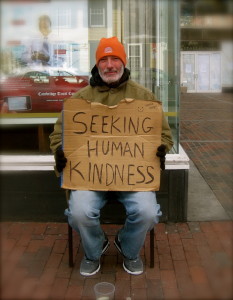
“Seeking human kindness” by Enver Rahmanov – Own work. Licensed under CC BY-SA 3.0 via Wikimedia Commons –
As I’m riding the overnight train from Chicago to New Mexico, an elderly African-American man in a wheelchair is taken off the train by paramedics, police, and the conductor. Earlier, I had heard the car attendant say something about a minor heart attack. The man, a double amputee, shivers in the cold night air as he argues with the authorities in words I cannot hear through the sealed train window. Fifteen minutes later, they put him back on the train, and we continue on our way.
By morning, the man’s physical distress is noticeable; an odor fills the train. The man has soiled himself. As I’m gathering my luggage in the lower car to step off at my stop, a conductor starts complaining loudly, about the smell.
“I thought they were going to throw him off in Kansas City,” he grumbles. “There are rules about offensive odors. Why should 50 people have to suffer all the way to Los Angeles because of this guy?”
I am shocked by the comment. The man is poor, probably homeless. It is possible he was put on the train in Chicago and sent to Los Angeles to survive the coming winter.
“I swear, I’m putting him off when we get to Albuquerque,” the conductor whines.
It snows in Albuquerque, my mind objects. The police shoot homeless people for fun in Albuquerque. My words are turning to dust in my mouth. I glance at the car attendant, hoping he’ll say something to the conductor. The car attendant shifts uncomfortably as we stand in the crowded vestibule. The elderly man can hear every word we say – and don’t say – through the thin door of the handicapped bathroom. The car attendant, a calm, Hispanic man tries to explain to his supervisor, who got on the train this morning, the complexity of the elderly man’s situation. The supervisor ignores him and over-dramatically opens the door of the moving train to let in fresh air.
The train slows as we near the station, hardly a minute or two have passed. I am frantically trying to spit out the words that are in a jumble on my tongue. In Chicago, more than 6,000 homeless people are preparing to survive six months of sub-zero temperatures. This man has no feet. He has possibly just survived a heart attack. He needs medical care in a nation that will not provide it. He needs our compassion, not our scorn.
The train stops. The conductor impatiently throws out the yellow step stool and tells me to get off – this is a 10-second stop. I am left on the platform in this remote corner of northern New Mexico, tears in my eyes, furious at my inarticulateness.
Standing there, Gandhi came to mind. Not the triumphant Mahatma Gandhi on top of his game, waging powerful nonviolent struggle for Indian independence from British Rule, but rather the young Mohandas K. Gandhi, who was thrown off a train in 1893, South Africa for refusing to give up his first-class seat because of the color of his skin. He spent the cold night sitting on the hard bricks of the station, confronting injustice and his sense of powerlessness. It was a potent, long night. In the morning, he rose with determination and resolve to end the injustice of discrimination he and his fellow Indians faced. We know the story from there.
Like young Gandhi, I spent an uncomfortable period at the train station reflecting on my personal failure. I failed my fellow human beings on the train. I failed myself, and my principles. I failed the man in the wheelchair. I failed the haunting memory of my diabetic father who faced amputations shortly before his death. I failed the car attendant who may have felt stuck between the opinions of his superior and the seeming agreement in my silence. I also failed the conductor, leaving him to continue his unthinking cruelty. I failed to challenge his discrimination. I left him with the impression that I – and other passengers – agreed with his assessment that his professionalism required him to throw a hurt, elderly man off at Albuquerque. I failed to explain that our slight discomfort at the smell is negligible compared to the suffering the man was enduring … and that we, as fellow human beings, could offer the slight balm to the man’s pain by showing him compassion and treating him with dignity.
As the train shrank on the horizon of the tracks, carrying the man, the conductor, and the car attendant into an unknown chapter of the unfolding story, I was left with the burning shame of having lowered my human dignity through silence and inaction. We all like to imagine ourselves as the heroes in the story, but I failed to step into the role and instead wound up on the sidelines, a minor character in the long plot of the world.
“Our lives begin to end the day we become silent about things that matter.” – Dr. Martin Luther King, Jr.
I died a little that day. This essay is an attempt to return to life, to step back into the living crucible of human existence. I share this story to begin to restore my diminished human dignity. I reflect here to prepare us both to act differently in the next moment, to succeed in speaking for justice and compassion. I hope we all find the words I lacked that day and the courage to speak them promptly. My silence may mean that man’s death. It also may not matter; someone else – the car attendant, another staff person, a passenger – may have intervened to assure the elderly man safe passage to Los Angeles. He may have wheeled out of the bathroom and given the conductor a piece of his mind. I do not know. I only know that my behavior left room for improvement.
I have heard that the Tibetans have no word for guilt. The closest approximation is a word that means, “intelligent regret decides to do differently.” Noticing wrong action is tied inextricably to changing the behavior. For myself, the lesson on the train is well taken. It came home powerfully to me over the next few days. I went over the situation again and again, practicing in my mind how to change my behavior. With more than half a million homeless people, and 46.7 million in our nation living below the poverty line, there is no doubt that I will face another situation like this again. It is only a question of when . . . and whether I will choose to make a choice that upholds the human dignity of us all.
____________________________
Author/Activist Rivera Sun, syndicated by PeaceVoice, is the author of The Dandelion Insurrection, Billionaire Buddha and Steam Drills, Treadmills, and Shooting Stars, the cohost of Occupy Radio, and the cofounder of the Love-In-Action Network. She is also the social media coordinator forCampaign Nonviolence and Pace e Bene. Sun attended the James Lawson Institute on Strategic Nonviolent Resistance in 2014 and her essays on social justice movements appear in Truthout and Popular Resistance.www.riverasun.com
November 14, 2015
Bombs Will Not Heal Our Broken Hearts
 In the past 36 hrs, I have watched and listened to hundreds of reactions of ordinary people to the attacks in Paris. With a clenched gut, I feared the reiteration of the sequence of 9/11: anger, shock, fear, calls for vengeance, war, and more violence.
In the past 36 hrs, I have watched and listened to hundreds of reactions of ordinary people to the attacks in Paris. With a clenched gut, I feared the reiteration of the sequence of 9/11: anger, shock, fear, calls for vengeance, war, and more violence.
Instead, I saw the unexpected, and a tendril of hope grew inside my heart. Here is some of what I saw:
Compassion for the scared, frightened, injured, killed.
A willingness to remember that all across the world, there are people frightened, hurt, angry, and lost.
An acknowledgment of the cycle of violence begetting violence begetting more and more violence.
A stark look at our own nation (the US) and our role in terrorism, invasion, drone strikes, illegal wars, destabilizing governments, regions, peoples.
The courage to speak up for an end to this vicious, horrific cycle. To say the unthinkable: that perhaps more war, bombs, weapons, troops, guns is not going to heal the broken hearts of Paris, Baghdad, Beirut, Yemen, Syria, United States, Iraq, Afghanistan, Palestine, Israel, and . . .
The knowledge that the list is endless. We speak the names of all the communities touched by violence, terrorism, war, destruction and the list is endless. We say their names as if reading out a roll call of the Earth.
And she is weeping, too.
Prayers are spoken, tears are falling, people are speaking, honesty and truth telling are breaking open the fear, giving room for compassion, until . . .
We see ourselves in the faces of the world. Our sorrows, their sorrows. Our fears, their fears. Our broken dreams, and theirs. Our wrong actions, and theirs. Our silence, their silence. Our courage, their courage. Our love, their love.
Our love.
In hundreds of comments, posts, tweets, words, emails, speeches, I am seeing a glimpse of the impossible: that you, my friends, love this Earth and all her inhabitants.
That you see this violence is killing us . . . each and every one of us. We cannot bomb our way to peace. We cannot shoot our way to safety. We cannot drone strike our sense of security back. That ‘terrorist’ is a label that could fall on the faces of us all. That our nation, like their nation, has picked up bombs and blown apart the fabric of human lives.
The words of our mothers come back to us, “two wrongs do not make a right”.
And no amount of bombs will fix our broken hearts.
Instead, we must do the impossible, the only thing that can get us out of darkness. We must break the cycle of violence. We must return hatred with understanding. We must search our souls for the truth about why and how these things occur. And then, we must work for change.
No one said it would be easy.
In the weeks to come, the usual voices on their large podiums and loudspeakers, their television networks, and radio chains, and conglomerate newspapers will start shouting about retribution and driving out terrorism, invasions, increased troops, more fighter jets, drones strikes, bombs. They will convince our friends and neighbors that we are the dreamers. They will tell us we are unpatriotic, that we want the terrorists to succeed.
Somehow, we will find the courage to tell them, as I once wrote in my novel, The Dandelion Insurrection, that “the terrorists have succeeded in making greater terrorists out of us.”
Unless we take a different course. A difficult course. The path we might have taken thirteen years ago, of seeing our face in those that we fear. In seeing the mirror of our common humanity. In seeking understanding instead of annihilation. In changing the course of history toward a world beyond the threat of violence. I am courageous enough to think this might be possible . . . and audacious enough to speak out, act up, and work with my fellow human beings to make this vision so.
Note: Thank you Christian Peacemaker Teams, for sharing the poem at the top in a social media post.
__________________________
Rivera Sun is the author of The Dandelion Insurrection, Billionaire Buddha andSteam Drills, Treadmills, and Shooting Stars, the cohost of Occupy Radio, and the cofounder of the Love-In-Action Network. She is also the social media coordinator forCampaign Nonviolence and Pace e Bene. Sun attended the James Lawson Institute on Strategic Nonviolent Resistance in 2014 and her essays on social justice movements appear in Truthout and Popular Resistance.www.riverasun.com
November 13, 2015
Cacerolazo: Pots and Pans Protest
 Know Your Nonviolent History (You’re Gonna Need It)
Know Your Nonviolent History (You’re Gonna Need It)
According to Wikipedia: “A cacerolazo, cacerolada, or casserole is a form of popular protest practiced in certain Spanish-speaking countries – in particular Venezuela, Argentina, Chile, Colombia, Uruguay, Cuba, Spain – and more recently English and French-speaking countries, most notably Québec, as well as in Turkey during the 2013 protests in Turkey and Brazil during the 2015 protests in Brazil – which consists in a group of people creating noise by banging pots, pans, and other utensils in order to call for attention.”
Cacerolazo protests allow people to demonstrate from their homes in repressive conditions, or take to the streets with pots in pans where possible. This creative nonviolent action has been used by people around the world because of its versatility and accessibility. After all, nearly everyone has a pot and spoon. Read more stories and details about the tactic of a cacerolazo protest on Beautiful Trouble’s website.
Stories and art are important ways of conveying the tools and tactics of resistance. As citizens facing challenging times and a wide range of social injustices, sharing ideas for effective action encourages and inspires us to work for change. To the right is a beautiful short film of the Montreal Casseroles Protests. The cacerolazo also played an important role in my novel, The Dandelion Insurrection, as citizens protested and noncooperated with the imposition of martial law in a (slightly) fictionalized United States, “just around the corner of today“. You can read the excerpt of that chapter below.
Can you imagine using a cacerolazo protest for an issue you are protesting? What if we got out our pots and pans for the next trade deal protest or climate justice demonstration? What if we held an all-night pots and pans demonstration protesting police brutality? What could you use a cacerolazo for?
EXCERPT:
THE DANDELION INSURRECTION
by Rivera Sun
CHAPTER FOURTEEN
. . . . .
Cacerolazo Countdown
It’s time! It’s time! the bird sang outside the attic window. Hidden in Rudy’s mother’s farmhouse, Charlie looked up from his writing. One by one, the birds had left their huddles on the telephone lines and begun to challenge the stubborn edge of spring. Orioles and chickadees, the starlings, jays, and swallows, the thrushes, finches, and the meadowlarks; all the birds had taken to wing. Warbles sang out from farmyard fences, backyard gardens, and city parks.
It’s time! the little bird chirped. The shift in seasons is upon us! It’s time! It’s time! It’s time!
Charlie scratched his growing stubble and looked longingly out at the bird in the leafing maple tree. He had consoled his itching impatience with a steady stream of writing. That was one thing, at least. The terrorist charges had him cooped up and caged up with clipped wings and chained feet . . . but they hadn’t stopped him from writing. He touched his pen to the page.
It’s time! the bird shrilled from the maple tree.
I know, Charlie thought, it’s time for martial law to end . . . but how?
A stray cow bellowed from the flowerbed. Rudy’s mother leaned out the window and banged a copper-bottomed pan with a wooden spoon.
“Go on,” she cried. “Git!”
Charlie looked up sharply. The clang of the pan rang in his thoughts. He scrawled an idea down and sent it flying.
On the following Monday, people across the country stepped out onto their porches and front stoops with solemn expressions. Arms crossed stubbornly over chests. Twilight turned gray. Curfew fell. They didn’t move. Soldiers ordered them inside. Feet stayed planted. It’s time, they said, the power’s back. The attacks are over. It’s time for martial law to end. The soldiers told them it could only be lifted on the President’s orders. The people shrugged. Consider yourselves warned, they said. The sun vanished. The people went indoors.
They reappeared in the windows with pots in hands. All across the country, the sound walked where their bodies couldn’t. Pots banged out their protest. Rhythm stepped across police blockades. Human spirit connected through the beat. The cacerolazo demonstration came from the Spanish speakers and the French. It passed like wildfire from city to suburb to town, igniting from the frustration of the people.
On Tuesday, the pots and pans rang out at dawn, calling the neighbors out of slumber. It’s time! It’s time! the clatter-racket rhythm insisted. The sharp retorts reverberated into tanks, rattled politicians’ offices, drove concentration out the window, disrupted meals, disturbed the peace, and drove officials crazy.
On Wednesday, the people in Rudy’s town were banned from banging on pots and pans. They pounded on their tractors and car hoods, instead. The local police were ordered to enforce noise ordinances. They refused. The military banned all drumming. Silence fell.
On Thursday, Inez Hernandez sent a message to Rudy.
“Turn on the radios. We’ll broadcast the racket from the city.”
Boom boxes appeared in windows. The shops put radios on the roofs. The local musicians hooked up their amplifiers and rang out the rhythms that were reverberating the city.
“Keep drumming!” Inez told her people. “The nation is listening!”
New York City had never pounded so hard.
On Friday night, the city shook. The suburbs shuddered. The rural regions roared. The racket connected cities to towns to countryside. Solidarity united the people. The sound grew monstrous and wild. It thrilled the soul with its thunderous cacophony. The people leaned out their windows, shocked by the uproar they had unleashed, stunned by the magnitude of the protest, awed by the volume of the masses.
On Saturday, the nation was ordered to desist. The response ricocheted back undeniably. There would be no quiet until martial law was ended! The Man From the North’s last article echoed in their ears: bang to end curfews! Pound to halt pipelines! Strike to stop gas wells! Hammer to get soldiers off our streets! Whatever your reason, get out your pans. We will not live under the thumb of tyranny!
On Sunday, the drumming fell into the rhythm of prayer. Hail Mary’s wafted with the ping-panging of pots. Churchgoers were told to strike three times in penance, four more in contrition, five times for their souls, and six for a miracle. That night, people swore the Devil got involved. Only Satan could have raised such a ruckus! No one slept, not in heaven, not in hell, and certainly not down here on earth. It was rumored that God or the Devil – or possibly both – twisted the ear of the Commander-in-Chief and told him that his mortal soul was at stake – not to mention his sanity, his sleep, his position, his authority, and his command of the troops – if he did not yield to the demands of his people!
Others proffered more secular causes: the atheists swore the stock market’s nosedive did the trick, the anarchists claimed the threat of societal collapse swayed the decision, the psychoanalysts swore the First Lady had threatened divorce, the Banker said it had been statistically inevitable, the Butcher blamed the Man From the North, the Candlestick Maker grumbled that the President had no balls, the people shook their heads at the lunacy of the others – any idiot could hear the real cause was the hammering – but all explanations aside, everyone agreed, on Monday a miracle occurred.
Martial law was finally repealed.
____________________________
If you enjoyed this excerpt, you’ll love The Dandelion Insurrection!
“When fear is used to control; love is how we rebel!” Under a gathering storm of tyranny, Zadie Byrd Gray whirls into the life of Charlie Rider and asks him to become the voice of the Dandelion Insurrection. With the rallying cry of life, liberty, and love, Zadie and Charlie fly across America leaving a wake of revolution in their path. Passion erupts. Danger abounds. The lives of millions hang by a thin thread of courage, but in the midst of the madness, the golden soul of humanity blossoms . . . and miracles start to unfold!
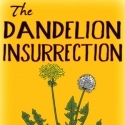 The Dandelion Insurrection"When fear is used to control; love is how we rebel!"
The Dandelion Insurrection"When fear is used to control; love is how we rebel!"Under a gathering storm of tyranny, Zadie Byrd Gray whirls into the life of Charlie Rider and asks him to become the voice of the Dandelion Insurrection. With the rallying cry of life, liberty, and love, Zadie and Charlie fly across America leaving a wake of revolution in their path. Passion erupts. Danger abounds. The lives of millions hang by a thin thread of courage, but in the midst of the madness, the golden soul of humanity blossoms . . . and miracles start to unfold! LEARN MORE>> Quantity: Price: $19.99
Rivera Sun is the author of The Dandelion Insurrection, Billionaire Buddha and Steam Drills, Treadmills, and Shooting Stars, the cohost of Occupy Radio, and the cofounder of the Love-In-Action Network. She is also the social media coordinator forCampaign Nonviolence and Pace e Bene. Sun attended the James Lawson Institute on Strategic Nonviolent Resistance in 2014 and her essays on social justice movements appear in Truthout and Popular Resistance. www.riverasun.com
From the Desk of Rivera Sun
- Rivera Sun's profile
- 161 followers




